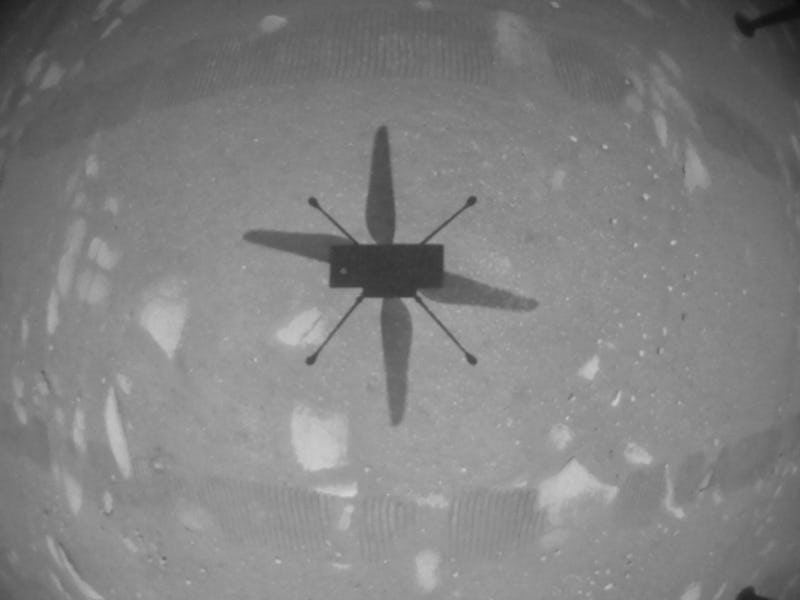NASA: Mars helicopter brings us into “the third dimension”
The little helicopter proved it could make history by flying on another planet.

Planetary scientist Paul Byrne, when thinking about the maiden flight of the Mars helicopter Ingenuity, couldn’t resist a pun.
“What we saw this morning was no less than an incredible feat of human, well, ingenuity!” Byrne tells Inverse.
On Monday morning, NASA’s Ingenuity helicopter lifted its scrawny legs 10 feet off the Martian ground. The four-pound helicopter wasn’t in the air for long, but in less than a minute, it made history.
“The sheer number of technical things that had to go right for that first flight — safe launch, safe delivery to the Martian surface, safe deployment from Perseverance, the ability of the helicopter to survive the cold Martian nights, the fact that there's no ground-in-the-loop and everything has to be automated and commanded ahead of time — is remarkable,” Byrne says.
Those mere 39 seconds marked the first powered, controlled flight of an aircraft on another planet in all of space exploration history, a major feat that will set the stage for a new way for humanity to explore other worlds. The Wright Brothers flyer — of which there’s a piece aboard Ingenuity — lasted only 12 seconds and still changed the world forever.
Ingenuity took off at around 3:30 a.m. ET. Ground control received word of the flight’s success shortly after, unveiling first images at 6:46 a.m. ET from flight headquarters at NASA’s Jet Propulsion Laboratory (JPL) in Southern California.
Ingenuity downlinked its data through its Martian companion, the Perseverance rover, which communicates to mission control via the Deep Space Network. In a press conference on Monday, JPL director Michael Watkins discussed how it opens up a new era of exploration.
“What the Ingenuity team has done is given us the third dimension,” Watkins says. “They freed us from the surface now forever [in terms of] planetary exploration.”
The Perseverance rover captured this footage of Ingenuity taking its first flight on Mars.
Ingenuity’s takeoff was not guaranteed. The team behind the helicopter designed the aircraft specifically to fly on Mars and tested it in a simulator before sending it off, but there was no way to know that it would actually work until it flew from the Red Planet.
Ingenuity flew to a maximum altitude of 10 feet and maintained a stable hover for 30 seconds, according to NASA. The helicopter then touched back down on the surface of Mars after logging a total of 39.1 seconds of flight.
The flight was autonomous, preprogrammed by the team at JPL since they cannot fly the helicopter from Earth in real-time considering that the data has to travel millions of miles between Earth and Mars.
On Mars, Ingenuity was piloted by its onboard guidance and navigation system. According to Thomas Zurbuchen, associate administrator of NASA’s Science Mission Directorate, it was an intricate technical feat.
“We all have a hard time finding that right line between crazy and innovative and it turns out we're often wrong with that line,” Zurbuchen says during the press conference. “This was a crazy idea that was being developed and this team put that idea into reality.”
Ingenuity landed on Mars on February 18, tucked inside the Perseverance rover.
Ingenuity’s initial flight was originally slated for April 8 but suffered some delay after the helicopter shut itself down unexpectedly during a high-speed rotor spin test.
In order to set it back on track, NASA’s engineers modified and reinstalled Ingenuity’s flight software to correct what Ingenuity project manager MiMi Aung describes as “an intricate timing issue.”
The helicopter is only 19 inches tall and weighs about four pounds, with two four-foot-long carbon-fiber rotors spinning in opposite directions.
“What will we be flying on Mars in 24 years' time? I can't wait to find out,” Byrne says.
This article was originally published on